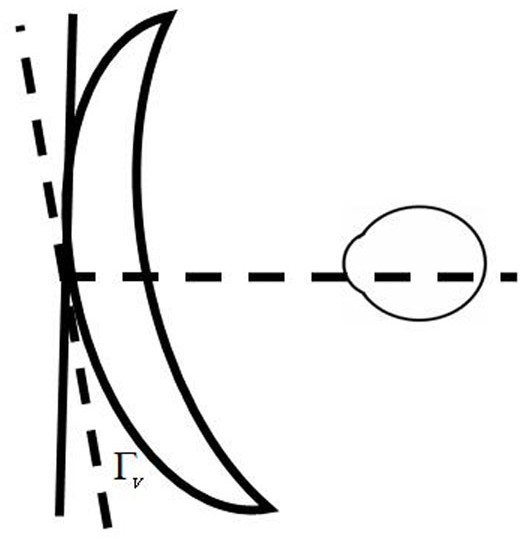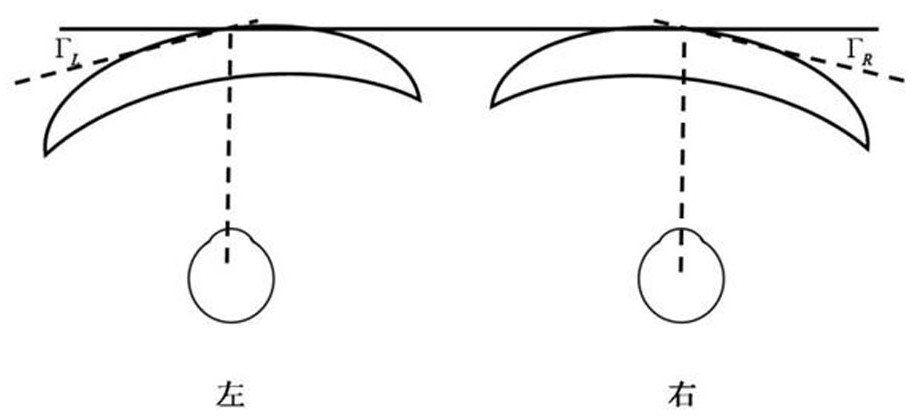Personalized peripheral myopia out-of-focus spectacle lens as well as design method and preparation method thereof
A design method and myopia technology, applied in glasses/goggles, optics, instruments, etc.
- Summary
- Abstract
- Description
- Claims
- Application Information
AI Technical Summary
Problems solved by technology
Method used
Image
Examples
Embodiment 1
[0041] This embodiment takes the right eye of a patient with ametropia whose myopia degree is -2D as an example, and provides a kind of peripheral myopic defocus spectacle lens with a personalized design. The outer (front) surface is spherical, and the inner (back) surface is For an asymmetric toroid, the design method of the inner surface is as follows:
[0042] Through the measurement of the open lens meter, it is obtained that the patient's naked eye is 10 degrees, 20 degrees, and 30 degrees on the nasal side, 10 degrees, 20 degrees, and 30 degrees on the temporal side, 10 degrees from the top, 20 degrees from the perspective, and near from the bottom. Peripheral hyperopic refractive power defocus values at 10° and 20° viewing angles are listed in the first column of Table 1 "Naked eye hyperopic defocus value (D)", where D is the symbol of the diopter unit. It shows that the hyperopic defocus increases significantly with the increase of the angle of view, and the temporal...
Embodiment 2
[0051] In this embodiment, taking the left eye of a patient with ametropia whose myopia degree is -6.5D as an example, a kind of peripheral myopic defocus spectacle lens with a personalized design is provided, the outer surface of which is a spherical surface, and the inner surface is an asymmetric superring Refer to Example 1 for the design and preparation method of the surface and inner surface.
[0052] In this embodiment, through the measurement of the open lens meter, it is obtained that the viewing angle of the patient's naked eye is 10 degrees, 20 degrees, and 30 degrees on the nasal side, 10 degrees, 20 degrees, and 30 degrees on the temporal side, and 10 degrees and 20 degrees on the upper side. The peripheral hyperopic defocus values at the near 10 degree and 20 degree viewing angles are listed in the first column of Table 2 "Naked eye hyperopic defocus value (D)"; the distance from the center of eye rotation to the center of the lens is 27.5 Calculate the position...
Embodiment 3
[0057] In this embodiment, the right eye of a patient with ametropia whose spherical myopia degree is -4D and astigmatism -2D is axially 20 degrees is taken as an example. A personally designed peripheral myopic defocus spectacle lens is provided, the outer surface of which is a spherical surface, and the inner surface is an asymmetric toroidal surface. For the design and preparation method of the inner surface, refer to Example 1.
[0058] In this embodiment, through the measurement of the open lens meter, it is obtained that the viewing angle of the patient's naked eye is 10 degrees, 20 degrees, and 30 degrees on the nasal side, 10 degrees, 20 degrees, and 30 degrees on the temporal side, and 10 degrees and 20 degrees on the upper side. Peripheral hyperopic defocus values at 10° and 20° viewing angles are listed in the first column of Table 3 "Naked eye hyperopic defocus value (D)"; the distance from the center of eye rotation to the center of the lens is 27 Calculate the ...
PUM
 Login to View More
Login to View More Abstract
Description
Claims
Application Information
 Login to View More
Login to View More - R&D
- Intellectual Property
- Life Sciences
- Materials
- Tech Scout
- Unparalleled Data Quality
- Higher Quality Content
- 60% Fewer Hallucinations
Browse by: Latest US Patents, China's latest patents, Technical Efficacy Thesaurus, Application Domain, Technology Topic, Popular Technical Reports.
© 2025 PatSnap. All rights reserved.Legal|Privacy policy|Modern Slavery Act Transparency Statement|Sitemap|About US| Contact US: help@patsnap.com



